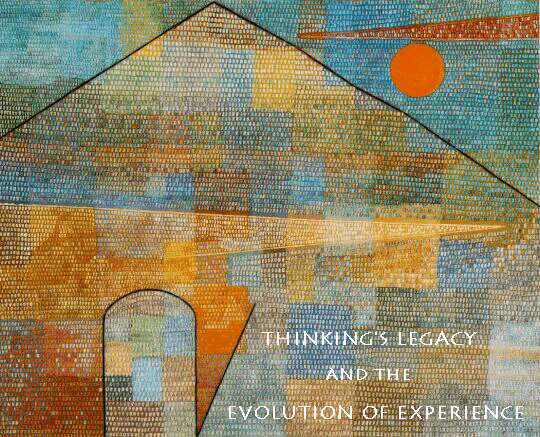
| |
|
|
 |
|
|
||
|
This essay offers concentrated
prose, intending to serve both as an advanced introduction to
thinking's recent developments, and as indicating the resources and
possibilities of thinking for meeting a future which can ever less
afford to be unthinking. The compass is set to
phenomena that express individuality and integration. The text unfolds
to comprehend thinking's journey through the 19th and 20th centuries;
as history, as changing relation to literary, religious, and scientific
meanings, and as part of the inexorable evolutionary probe into the
possibilities conjoining mind and life.
|
Philosophy worth the name has
wonder as its constant Muse, often named transcendence.
What is exists - and is experienced - in the
radiance of Possibility. Many works of art here lend help to keep
transcendence in sight. Paul Klee's Ad Parnassum
graces this page, perhaps because to show wholeness
from the tangled strands of history is to fashion a kind of fuzzy
mosaic that hangs in time like music. On a related note, philosophy
owes its specific capability to the possibilities of language,
so Shakespeare's river
of voices flows here everywhere as chords to save the meanings from
going flat.
|
||||
|
|||||
| |
|
|||
| |
|
|||
| |
Thinking
crosses from the Nineteenth to the Twentieth century, but its cultural
centering does not hold.
|
|||
|
|
The roles of
ideas change for thinking as the centrality of process and temporality
gain recognition. Is thinking more like science or art?
|
|||
|
|
Earlier ways
thinking had shifted in its relations with ideas; Immanuel Kant's critical
philosophy, G. W. F. Hegel's
dialectics, the emergence of ideology.
|
|||
|
|
In a quest to
cure itself of ideology and find its proper heir, philosophy
contemplates ending itself or turning itself inside-out.
|
|||
|
|
Hinges of
revolutions in thinking. Roles of ideas in cognition versus
'transformative practice' at the threshold of the Twentieth century.
|
|||
|
|
New foundations
for subjectivity: Edmund Husserl's
phenomenology and Wilhelm Diltheys'
hermeneutics show how immersion in presence opens
thinking beyond ideas.
|
|||
|
|
New foundations
for objectivity: concepts as forms of potential for experience in Alfred North Whitehead and Friedrich Nietzsche. The reach
and synthesis of concepts as forms of potential exhibits thinking's
openness toward the future.
|
|||
|
|
New foundations
for meaning: In Ernst Cassirer
and Rudolf Steiner
myth uncovers metaphor as meaning's deepest roots and as the basis of
thinking's openness to the past. Religion's way of
conjoining presence, future and past as opennesses.
|
|||
|
|
Martin
Heidegger's revolutionary attempt to integrate thinking's
openness to future, past, and present. His need to reshape Truth's
meaning.
|
|||
|
|
Factors missing
from Heidegger's kind
of temporal thinking; Nietzsche's
values on play and life; Paul
Ricoeur's exploration of metaphor and narrative
temporality; Susanne Langer's
organic approach to symbolic form.
|
|||
|
|
Modeling the
integration of factors required for a comprehensively temporal
thinking. Gregory Bateson's
perspective. Meaning's situation between objectivity and subjectivity. Henri Bergson and William James show up again. Is
Plurality more basic than Unity?
|
|||
|
|
Gilles
Deleuze's 'polyrhythmic' approach to objectivity and its
impact on the status of concepts as given in VI(b), above.
|
|||
|
|
Emmanuel
Levinas grounds subjectivity in exposure and expression;
the significance for Husserl's
objectives as described in VI (a),
above.
|
|||
|
|
Temporal
thinking is pluralistc. Proximity. Understandings of Mind and Life can
guide each other by their common ground of individualization and
integration. The dimensions of temporal openness isolated in the three
parts of section VI, above, meet in
lived experience as sense, concept,
and meaning. The challenge for thinking of a 'wisdom
of love'.
|
|||
|
||||
|
||||
|
||||
 |
|
 |
|
The Copyright holder grants permission for free personal use, and noncommercial on-line use, of this text.
|
|||||||